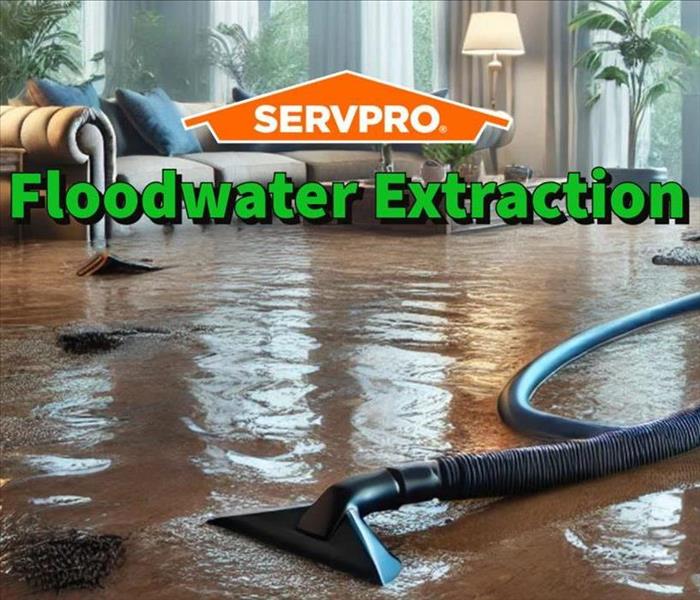Floodwater Extraction: 6 Proven Steps for Restoration
12/27/2024 (Permalink)
Learn Why Effective Floodwater Extraction Is Critical After a Flood!
Flooding can devastate residential and commercial properties, leaving extensive water damage threatening structural integrity and valuable possessions. Quick and effective floodwater extraction is essential to prevent long-term damage and restore properties to their original condition. SERVPRO® has the expertise, advanced equipment, and dedicated professionals to handle these emergencies with efficiency and care.
This blog post will explore the causes of flooding, detail critical steps for floodwater extraction, and showcase how SERVPRO provides unmatched service for properties affected by flooding.
What Are the Common Causes of Flooding?
Flooding can occur for many reasons, and understanding the causes is vital for effective prevention and response. Here are some common scenarios that lead to flooding:
- Severe Weather: Heavy rainfall and hurricanes can quickly overwhelm drainage systems, leading to widespread flooding.
- Blocked Drainage Systems: Clogged gutters, drains, and culverts impede water flow, causing water to accumulate and flood properties.
- Burst Pipes: Excessive water pressure or aging infrastructure can cause pipes to fail, leading to sudden water intrusion.
- Dam Failures: Structural failures in dams or levees can unleash large amounts of water, flooding nearby areas.
- Flash Floods: Rapid water accumulation in low-lying areas during intense storms is a significant cause of flash flooding.
Understanding these factors can help property owners prepare and minimize the risk of water intrusion.
Steps for Effective Floodwater Extraction
Floodwater extraction requires immediate action and careful attention to detail. Below are the essential steps involved in the process:
Step 1: Initial Assessment and Safety Check
Before any work begins, professionals assess the property for hazards such as electrical issues or structural instability. This ensures the safety of everyone involved.
Step 2: Stopping the Source of Water
If the flooding results from internal issues, such as burst pipes, the first step is to stop the water flow. Locate and shut off the main water supply to prevent further damage.
Step 3: Removing Standing Water
Using high-powered pumps and vacuum systems, SERVPRO professionals efficiently extract standing water. This crucial step minimizes water spread and prevents further structural damage.
Step 4: Drying and Dehumidification
After extraction, drying and dehumidification are critical. SERVPRO uses industrial-grade air movers and dehumidifiers to eliminate moisture, even in hard-to-reach areas. Proper drying prevents warping, mold growth, and other secondary damage.
Step 5: Cleaning and Sanitizing
Floodwater often contains contaminants like dirt, debris, and microorganisms. Thorough cleaning and sanitization are necessary to restore the property to a safe condition.
Step 6: Monitoring and Preventive Measures
SERVPRO ensures the restoration process is complete by monitoring moisture levels and applying preventive treatments to guard against future issues.
A Recent Floodwater Emergency in Athens, Georgia
Last month, a homeowner in Athens, Georgia, contacted SERVPRO after experiencing a flood caused by a clogged drainage system during an intense thunderstorm. The flooding led to several inches of standing water in the basement, threatening the home's foundation and valuable possessions stored there.
Once the call came in, SERVPRO mobilized immediately. The response plan included:
- Rapid Floodwater Extraction: High-powered pumps removed the standing water in a matter of hours.
- Comprehensive Drying: Industrial-grade drying equipment eliminates all moisture, protecting the basement from further damage.
- Thorough Cleaning: The team sanitized the affected areas to ensure a safe and healthy environment.
- Preventive Recommendations: SERVPRO provided tips to prevent future flooding, including clearing gutters and improving drainage systems.
The homeowner was impressed with SERVPRO's efficiency and professionalism, ensuring their property was restored quickly and effectively.
Tips to Prevent Flood Damage
While flooding is not always avoidable, proactive measures can reduce its impact. Consider these tips:
- Maintain Drainage Systems: Regularly inspect and clear gutters, downspouts, and drainage channels.
- Install Flood Barriers: Protect entry points with barriers or flood-resistant doors.
- Elevate Critical Systems: Raise HVAC units, electrical panels, and appliances to reduce damage risk.
- Seal Foundation Cracks: Fill any gaps in the foundation to prevent water seepage.
- Landscaping Adjustments: Ensure proper grading around your property to direct water away from the building.
- Invest in a Sump Pump: A sump pump can help remove water from basements during flooding.
- Use Smart Technology: Install water sensors and leak detectors to get alerts about potential issues.
Why Choose SERVPRO for Floodwater Extraction?
Floodwater extraction requires more than basic cleanup—it demands expertise, advanced equipment, and attention to detail. SERVPRO stands out as a trusted restoration partner, offering:
- Rapid Response: We arrive quickly to prevent further damage and minimize downtime.
- Skilled Technicians: Our IICRC-certified team is trained to handle complex restoration scenarios.
- Advanced Equipment: We use state-of-the-art tools to ensure effective restoration from high-powered pumps to industrial-grade dehumidifiers.
- Comprehensive Services: Beyond extraction, we offer cleaning, sanitizing, and preventive consultations tailored to each property.
Wrapping Up
Floodwater can cause widespread damage, but restoration is achievable with timely action and professional help. SERVPRO specializes in swift, reliable floodwater extraction and property restoration. Our dedication to quality service ensures peace of mind for property owners facing the aftermath of flooding.
When you need floodwater extraction, trust SERVPRO to be your partner in restoring and protecting your property. Contact SERVPRO today to learn more about our comprehensive restoration services in your area.





 24/7 Emergency Service
24/7 Emergency Service
